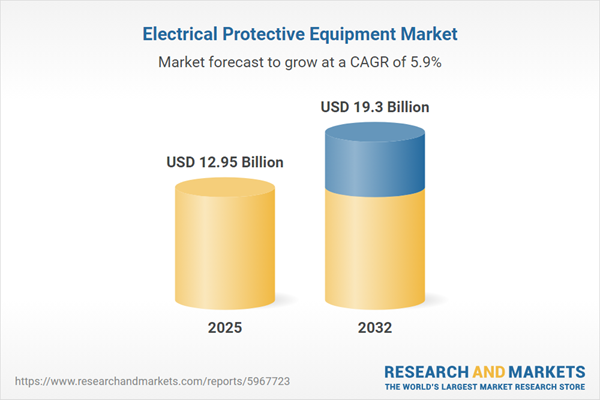Speak directly to the analyst to clarify any post sales queries you may have.
Electrical protective equipment is increasingly vital in global power infrastructure, protecting systems from evolving hazards while supporting reliability and operational continuity. As regulatory, technological, and supply chain complexities expand, senior executives are turning toward data-driven strategies and agile solutions to maximize safety, efficiency, and market advantage.
Market Snapshot: Electrical Protective Equipment Market Overview
The electrical protective equipment market grew from USD 12.24 billion in 2024 to USD 12.95 billion in 2025. Forecasts indicate sustained expansion at a CAGR of 5.85%, with market value projected to reach USD 19.30 billion by 2032.
Demand is driven by modernization of power systems, distributed energy adoption, increasing regulatory rigor, and the need for advanced protection across diverse end-user sectors.Scope & Segmentation: Strategic Coverage of the Electrical Protective Equipment Market
- Product Types: Circuit breakers (high, medium, low voltage), fuses (fast acting, time delay, high rupturing capacity, microfuse), isolators (indoor, outdoor), protective relays (electromechanical, static, numerical), residual current devices (RCBO, RCCB), surge protective devices (Type 1, Type 2, Type 3).
- End Users: Aerospace and defense (commercial aviation, military), automotive (OEM, aftermarket), construction (commercial, residential), energy and utilities (power generation, transmission and distribution), telecommunication (network infrastructure, telecom equipment).
- Distribution Channels: Direct sales (OEM contracts, system integrators), distributor (retailers, wholesalers), e-commerce (manufacturer websites, third-party platforms).
- Geographic Segments: Americas (North America, Latin America), Europe, Middle East & Africa (Europe, Middle East, Africa), Asia-Pacific (including major economies such as China, India, Japan, Australia, and others).
- Technology Advancements: Emphasis on digitalization, predictive maintenance, modular protection systems, integration of IoT sensors, cloud connectivity, and cybersecurity enhancements.
Key Takeaways: Strategic Insights for Senior Decision-Makers
- Protective equipment now plays an active role in grid optimization, not merely in safety, as digital transformation accelerates system intelligence and interoperability.
- Utilities, industries, and infrastructure operators are focused on solutions that enable predictive diagnostics, real-time monitoring, and adaptive protection against complex grid scenarios.
- Procurement strategies are shifting in light of tariff pressures, with manufacturers seeking local sourcing, distribution partnerships, and flexible supply chains to ensure resilience.
- Market segmentation reveals differentiated requirements: aerospace and defense value rigorous standards, automotive emphasizes rapid replacement, and energy utilities prioritize uptime and compliance.
- Regional expansion requires aligning product strategies with diverse regulatory frameworks, electrification initiatives, and risk management needs across the Americas, EMEA, and Asia-Pacific.
Assessing Tariff Impact on Cost Structures and Supply Chains
The 2025 United States tariff measures have triggered cost pressures and realignment across the supply chain. Increased duties on specialized components have prompted local sourcing, near-shoring, and intensified supplier negotiations. End users respond by diversifying supply bases, leveraging consortium agreements, and adopting alternative materials. While short-term costs rise, these adaptations are reinforcing ecosystem resilience and supply chain transparency.
Electrical Protective Equipment Market Methodology & Data Sources
This report combines comprehensive secondary research, rigorous literature reviews, and triangulation from industry publications, regulatory filings, customs data, and trade associations. It is further strengthened by primary interviews with executives, engineers, and procurement leaders across core sectors, as well as targeted surveys measuring sentiment toward digital protection solutions. Data validation and scenario analysis protocols ensure accurate, actionable findings for stakeholders.
Why This Report Matters for Your Strategic Objectives
- Enables leaders to anticipate market shifts and proactively manage regulatory, technological, and supply chain risks in an increasingly dynamic sector.
- Supports informed investment decisions and targeted portfolio optimization by providing granular insight into products, end user priorities, distribution strategies, and regional market opportunities.
- Helps organizations strengthen competitive positioning by aligning with sustainability goals, leveraging digital ecosystems, and fostering workforce innovation.
Conclusion
The electrical protective equipment market is entering a new era defined by digital integration, supply chain resilience, and regulatory adaptation. Organizations that leverage data-driven insights and agile strategies will be best positioned for long-term growth and operational security.
Additional Product Information:
- Purchase of this report includes 1 year online access with quarterly updates.
- This report can be updated on request. Please contact our Customer Experience team using the Ask a Question widget on our website.
Table of Contents
3. Executive Summary
4. Market Overview
7. Cumulative Impact of Artificial Intelligence 2025
Companies Mentioned
The companies profiled in this Electrical Protective Equipment market report include:- Siemens Aktiengesellschaft
- ABB Ltd.
- Schneider Electric SE
- Eaton Corporation plc
- General Electric Company
- Mitsubishi Electric Corporation
- Fuji Electric Co., Ltd.
- Emerson Electric Co.
- Schweitzer Engineering Laboratories, Inc.
- LS Electric Co., Ltd.
Table Information
| Report Attribute | Details |
|---|---|
| No. of Pages | 196 |
| Published | October 2025 |
| Forecast Period | 2025 - 2032 |
| Estimated Market Value ( USD | $ 12.95 Billion |
| Forecasted Market Value ( USD | $ 19.3 Billion |
| Compound Annual Growth Rate | 5.8% |
| Regions Covered | Global |
| No. of Companies Mentioned | 11 |









